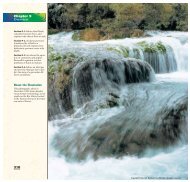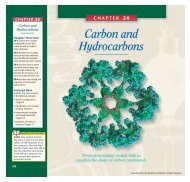Physical Characteristics of Gases
Physical Characteristics of Gases
Physical Characteristics of Gases
Create successful ePaper yourself
Turn your PDF publications into a flip-book with our unique Google optimized e-Paper software.
The Kinetic-Molecular<br />
Theory <strong>of</strong> Matter<br />
I n Chapter 1, you read that matter exists on Earth in the forms <strong>of</strong><br />
solids, liquids, and gases. Although it is not usually possible to observe<br />
individual particles directly, scientists have studied large groups <strong>of</strong> these<br />
particles as they occur in solids, liquids, and gases.<br />
In the late nineteenth century, scientists developed the kineticmolecular<br />
theory <strong>of</strong> matter to account for the behavior <strong>of</strong> the atoms and<br />
molecules that make up matter. The kinetic-molecular theory is based<br />
on the idea that particles <strong>of</strong> matter are always in motion. The theory can<br />
be used to explain the properties <strong>of</strong> solids, liquids, and gases in terms <strong>of</strong><br />
the energy <strong>of</strong> particles and the forces that act between them. In this section,<br />
you will study the theory as it applies to gas molecules. In that<br />
form, it is called the kinetic-molecular theory <strong>of</strong> gases.<br />
The Kinetic-Molecular<br />
Theory <strong>of</strong> <strong>Gases</strong><br />
The kinetic-molecular theory can help you understand the behavior <strong>of</strong><br />
gas molecules and the physical properties <strong>of</strong> gases. The theory provides<br />
a model <strong>of</strong> what is called an ideal gas. An ideal gas is an imaginary gas<br />
that perfectly fits all the assumptions <strong>of</strong> the kinetic-molecular theory.<br />
The kinetic-molecular theory <strong>of</strong> gases is based on the following five<br />
assumptions:<br />
1. <strong>Gases</strong> consist <strong>of</strong> large numbers <strong>of</strong> tiny particles that are far apart relative<br />
to their size. These particles, usually molecules or atoms, typically<br />
occupy a volume about 1000 times greater than the volume<br />
occupied by particles in the liquid or solid state. Thus, molecules <strong>of</strong><br />
gases are much farther apart than those <strong>of</strong> liquids or solids. Most <strong>of</strong><br />
the volume occupied by a gas is empty space. This accounts for the<br />
lower density <strong>of</strong> gases compared with that <strong>of</strong> liquids and solids. It<br />
also explains the fact that gases are easily compressed.<br />
2. Collisions between gas particles and between particles and container<br />
walls are elastic collisions. An elastic collision is one in which there is<br />
no net loss <strong>of</strong> kinetic energy. Kinetic energy is transferred between<br />
two particles during collisions. However, the total kinetic energy <strong>of</strong><br />
the two particles remains the same as long as temperature is constant.<br />
Copyright © by Holt, Rinehart and Winston. All rights reserved.<br />
SECTION 10-1<br />
OBJECTIVES<br />
State the kinetic-molecular<br />
theory <strong>of</strong> matter, and describe<br />
how it explains certain<br />
properties <strong>of</strong> matter.<br />
List the five assumptions <strong>of</strong><br />
the kinetic-molecular theory<br />
<strong>of</strong> gases. Define the terms<br />
ideal gas and real gas.<br />
Describe each <strong>of</strong> the following<br />
characteristic properties <strong>of</strong><br />
gases: expansion, density,<br />
fluidity, compressibility,<br />
diffusion, and effusion.<br />
Describe the conditions under<br />
which a real gas deviates<br />
from “ideal” behavior.<br />
PHYSICAL CHARACTERISTICS OF GASES 303<br />
SECTION 10-1<br />
Lesson Starter<br />
Open a bottle <strong>of</strong> strong-smelling<br />
perfume or dilute ammonia solution in<br />
the middle <strong>of</strong> the classroom. Ask students<br />
to raise their hand when they<br />
first detect the odor <strong>of</strong> the vapor. Ask<br />
them to try to explain this event in<br />
terms <strong>of</strong> the motion <strong>of</strong> molecules.<br />
Safety: Be sure no one breathes<br />
the fumes directly from or close to<br />
the bottle.<br />
Class Discussion<br />
You may choose to begin this chapter<br />
by discussing the fundamental<br />
physical properties <strong>of</strong> gases covered<br />
on pages 304 through 306, then<br />
introduce the kinetic-molecular<br />
theory <strong>of</strong> gases.<br />
To clarify the differences between<br />
an ideal gas and a real gas, discuss<br />
other instances in which real and<br />
ideal situations exist. For example, an<br />
ideal car might be completely energyefficient,<br />
but a real car loses energy<br />
through friction and unburned fuel.<br />
Ideal situations are important models,<br />
but ideal situations rarely, if ever,<br />
exist in real life.<br />
Module 1: States <strong>of</strong> Matter/Classes<br />
<strong>of</strong> Matter Module 1: States <strong>of</strong> Matter/Classes<br />
<strong>of</strong> Matter<br />
Topic: <strong>Gases</strong><br />
Section c <strong>of</strong> this engaging tutorial<br />
reviews and reinforces understanding<br />
<strong>of</strong> gases.<br />
NSTA<br />
TOPIC: <strong>Gases</strong><br />
GO TO: www.scilinks.org<br />
sci LINKS CODE: HC2101<br />
303

















